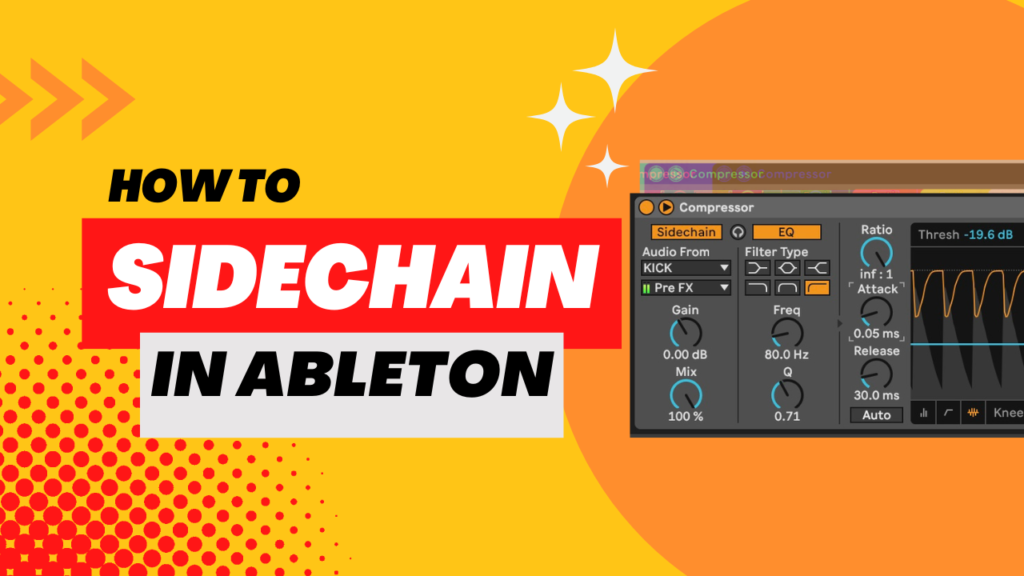Ever noticed that many plugins let you switch certain parameters from BPM to Hz? Or – even stranger – how Hz is used for timing when it is typically associated with pitch and tone? This can seem weird for electronic music producers, where the genres are very BPM-focused.
In this article, we will explore the relationship between BPM and Hz. We’ll show how to quickly and easily convert values from BPM to Hz. We’ll go deeper. Explaining what this value means, and how and when you would actually use this calculation.
As a music producer or audio engineer, understanding the various technical aspects of plugins is essential to creating great music. Knowing how to manipulate Hz intentionally will let you get the sound you want quickly.
I spent years as a producer afraid of using Hz. I never understood what it meant, or how to use it. But it’s nothing to be afraid of. One more tool in your kit to get the exact sound you want. And, with all things, remember there are no hard and fast rules – so if it sounds good, go for it.
Or, click here if you want to jump to a quick reference of tables of BPM to Hz conversions.
Table of Contents
BPM to Hz
The formula to convert BPM to Hz is: Hz = (BPM / 60) * Beats per cycle
This yields a conversion factor of 0.016667 Hz per BPM.
Some common conversions include: 120 BPM = 2 Hz, 128 BPM = 2.13 Hz, 140 BPM = 2.33 Hz, and 172 BPM = 2.87 Hz.
What is BPM
BPM stands for Beats Per Minute. It measures the tempo of a song. It represents how many beats occur in one minute, and it’s used to describe the overall speed or pace of a piece of music.
BPM is critical for DJs because it helps them match the tempo of different tracks and create seamless transitions.
Many genres of electronic music specifically have characteristic BPM ranges, seen below:
| Genre | BPM |
|---|---|
| House | ~128 BPM |
| Dubstep | ~140 BPM |
| Drum & Bass | ~172 BPM |
Most music production software includes a built-in tempo setting, and metronome or “click track.”
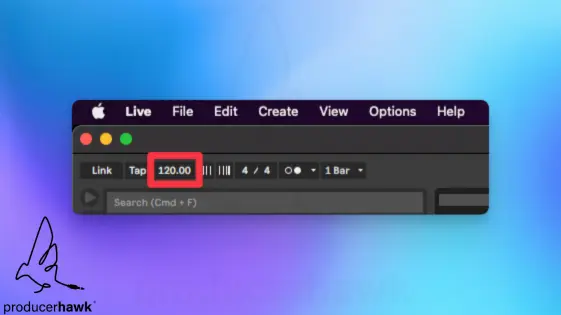
Plugins that have a BPM value are typically used to synchronize musical elements, such as drums or percussion, or time effects, like delay, with the tempo of the song.
What is Hz
Hertz (Hz), is a measure of frequency. It is the number of times a sound wave oscillates per second, or the number of cycles that a sound wave completes in one second.
Since Hz is a ratio of cycles (or oscillations) per second, we know that 1Hz equals 1 oscillation per 1 second.
Here, in one second, the wave moves from the start to the end. This scales up linearly. A wave with a frequency of 100 Hz will cycle 100 times in a second, and so on.
Because Hz describes a wave, it has a few different applications.
Converting BPM to Hz
Now you understand that both BPM and Hz measure a speed. Now, we can derive a simple formula to convert between BPM and Hz.
The formula to convert BPM to Hz is: Hz = (BPM / 60) * Beats per cycle
Let’s break that down. The facts:
- BPM is beats per minute.
- Hz is cycles per second.
- There are 60 seconds in 1 minute.
So, by simply dividing your BPM by 60 you’ll get beats per second.
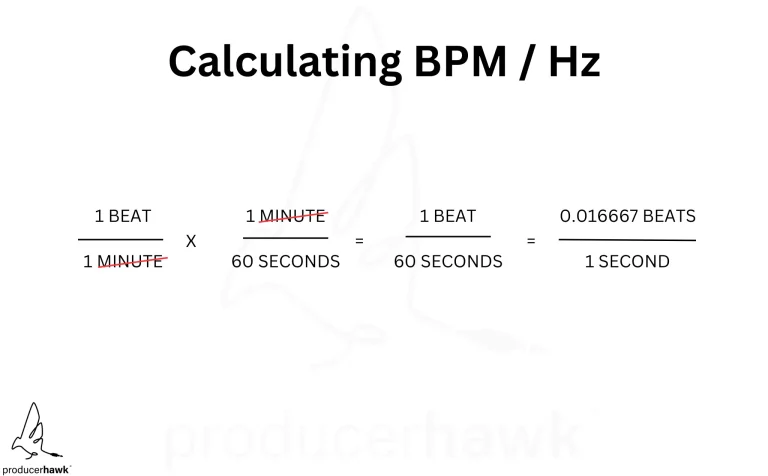
If your wave cycles every 1 beat, then you’re done! But, if there are more than 1 beat in each cycle of your wave (or, a fraction of 1 beat), you’ll need to multiply your result by the number of beats per cycle.
You can simplify this formula to a conversion factor. 1 / 60 = 0.0166667 Hz per BPM.
If you multiply this number by your BPM you’ll get the corresponding Hz value at one beat per cycle.
“So what?” you say! “Why do I need two ways to measure the same information?”
Fair point! Let’s explore some use cases.
How are BPM and Hz used?
Above we mentioned Hz measures frequency.
But, when we think of frequency it’s usually describing the pitch or tone of a sound. Lower frequencies produce lower-pitched sounds. Higher frequencies produce higher-pitched sounds.
Fun fact: doubling a frequency makes an exact octave jump. For example a sound wave with a frequency of 220 Hz will produce an A3 note, and a frequency of 440 Hz will produce A4.
If you’re looking for a table with all these frequency note values, check out this one.
The relation between notes and frequencies are helpful when EQing. Get surgical, knowing exactly what frequency you’re targeting.
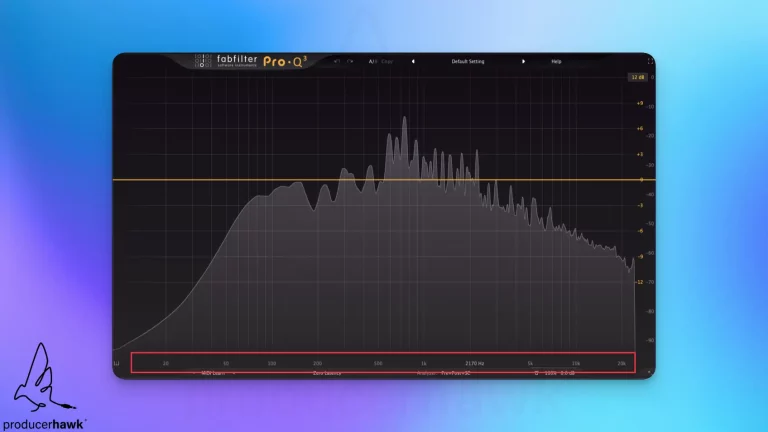
Hz frequency values are also good to tune instruments, and build harmonic relationships between elements of a track.
But it doesn’t account for why we’d ever want to or need to convert Hz frequency information to BPM.
In the example above the Hz are measuring the frequency of a sound wave. But Hz can be used to measure the frequency of any wave. Including the speed of Low Frequency Oscillators (LFOs) within synths and effect plugins.
In the examples below we’ll show how you can use Hz or BPM to control the timing of an effect.
Aligning BPM, Hz, and Time
Let’s take a 120 BPM song as an example.
To speak in terms of Hz, we’ll need to express this tempo in seconds.
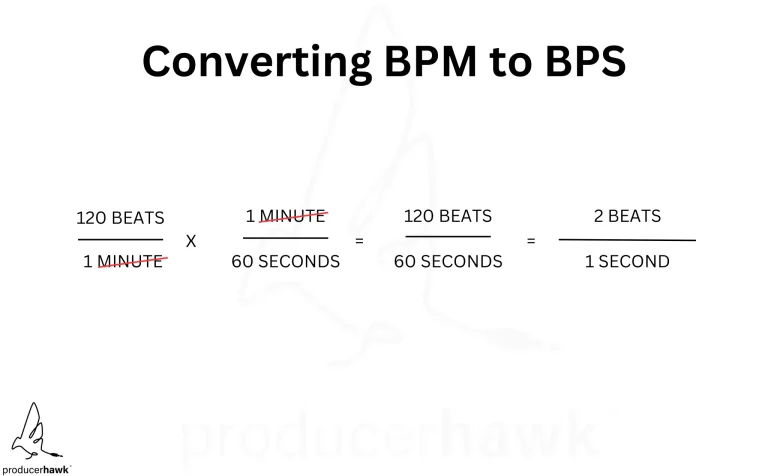
So, the equivalent of 120 beats per minute is 2 beats per second.
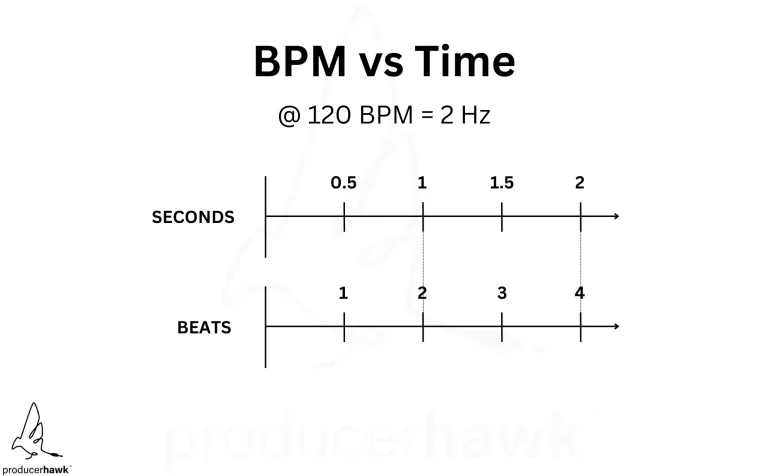
If you want an LFO to cycle on every beat, you’ll need to do our calculation. 120 BPM / 60 * 1 beat per cycle = 2 Hz. Or, as we’ve learned this means, 2 Hz means the wave will cycles 2 times per second.
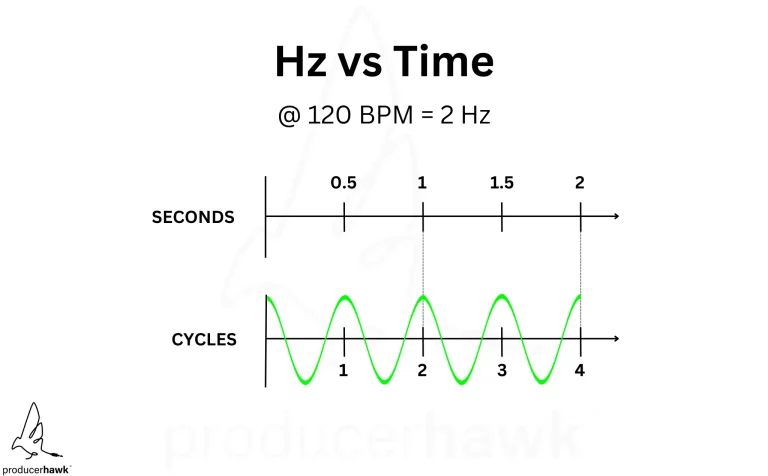
Bringing this all together, you can see that this oscillator setting will cycle every beat.
Or, you can divide it by 2 for the Hz setting for every ½ beat, or by 4 for every ¼ and so on.
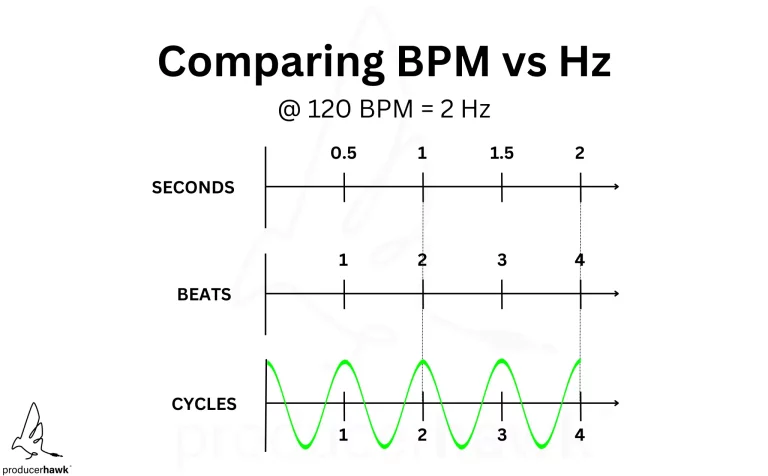
Using the BPM (or sync) setting does this calculation automatically. If you set it to 1, it will produce the same effect.
Let’s see how this works in practice:
Controlling an LFO inside a synth
Most synths have LFO functions. In Serum for instance, you can often draw a custom envelope that controls the shape of an LFO. But how fast does this pattern cycle? Well you can control its frequency with either BPM or Hz.
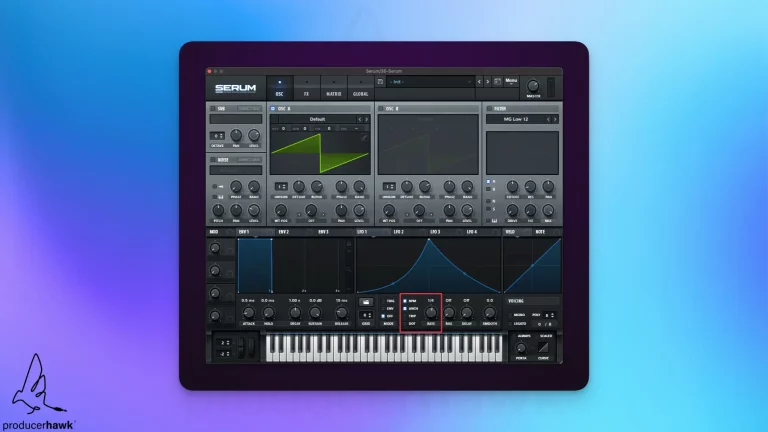
Effects with an LFO
Some effects have LFOs built into them. Ableton’s Auto Filter, Auto Pan, and Chorus-Ensemble all have a “Rate” setting that controls the speed of the speed of the effect’s cycles.
Note in the images how each of these plugins displays a wave, that the Hz rate will define the frequency of.
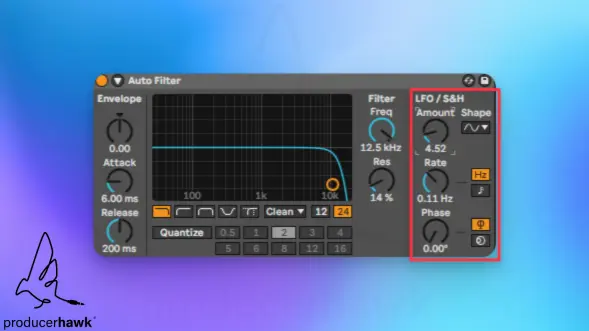
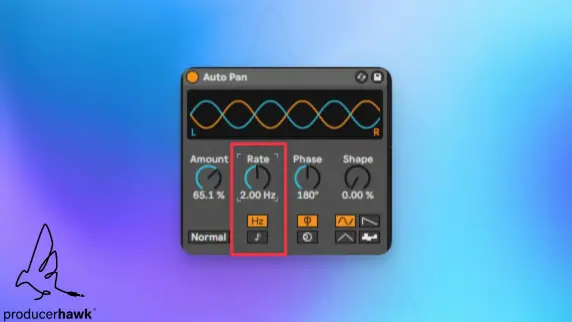

One Level Deeper: Hz to ms
Hz describes cycles per second. Knowing that millisecond (ms) is 1/1000th of a second lets us easily convert between Hz to ms with the formula Hz * 1000 = ms.
Some effects with long tails use timing controls in ms. Abelton’s delay can be set in ms, as can the decay rate of the reverb.
With delay it’s easy enough to use the BPM sync function to make sure the delay lands on a beat. But ms can be helpful if you want the delay on some fraction of a beat that isn’t offered in the sync menu (like a triplet). Also, ms is best for the haas effect.
Delay is a classic example of where using Hz to get a sound off the grid to give it a more organic feeling could be a desirable effect.
For reverb you can use the conversion to control reverb tails in the mix. Let’s assume a 120 BPM song again. If a sound hits on the downbeat, you can use 2Hz * 1000 / 2 = 1000 ms (or 1s) to ensure the reverb has completely decayed before the next downbeat.
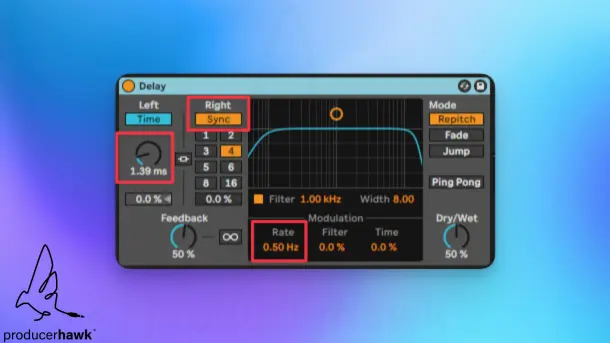
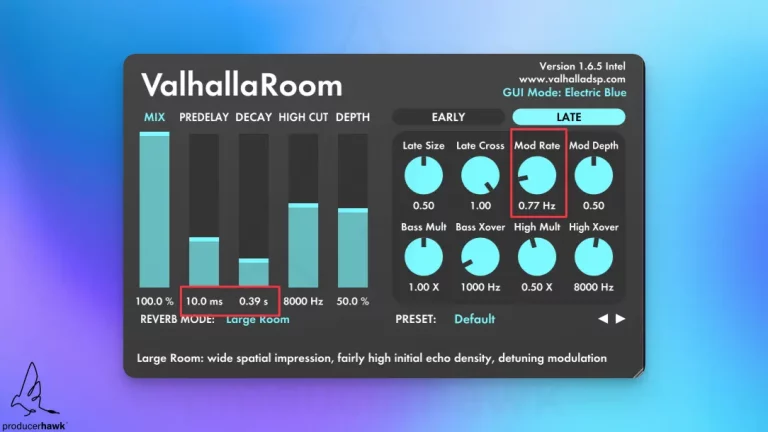
Which should I use: BPM or Hz?
The decision to use BPM or Hz depends on the specific task at hand.
If you’re working on a track and want to ensure that all elements are in sync with each other, using BPM is a great way to go.
Or, if you’re looking for a more asynchronous or organic feel to a sound or effect, you may be better off using Hz.
One thing to consider is the cost of changes when your rates are set manually. If you change your track tempo, your DAW will automatically keep all oscillators in BPM mode synced. If not, you’ll have to recalculate the Hz settings, and update them manually.
Conclusion: BPM to Hz
Knowing how to use both BPM and Hz to control timing in your song’s components is an important skill. BPM is beats per minute, and Hz describes the cycles of a wave per second.
Here is a quick comparison:
| BPM | Hz | |
|---|---|---|
| Measures | Tempo | Frequency |
| Definition | Beats per minute | Cycles per second |
| Use | Sets tempo of a track, synchronize effects to that tempo | Sets speed of LFOs. Describes pitch or tone to tune instruments or adjust EQ settings |
| Conversion Factors | 0.0166667 Hz | 60 BPM |
You can easily convert BPM to Hz with the formula Hz = (BPM / 60) * Beats per cycle, or the conversion factor of 0.0166667 BPM.
BPM is a great way to control rhythmic effects, and LFOs within synths and other plugins. Especially because if you update the track tempo, these values will update automatically.
Hz is a great tool for fine control over LFOs in synths and timed effects. You multiply any Hz amount by 1000 to get its corresponding millisecond value. This is important for controlling reverb tails.
You can experiment to find out which you like best.
Both are great tools to be familiar with.
For an amazingly detailed table of BPM to Hz conversion info, check this one.



